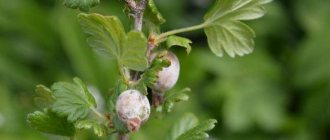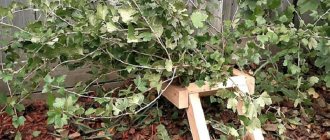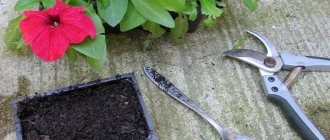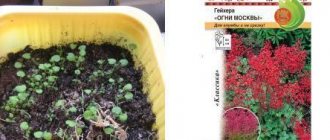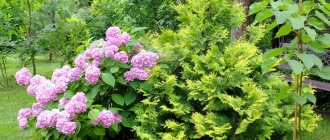Petunia is an unpretentious plant that can grow and bloom profusely even in conditions that are not the most favorable for it. This flower is rarely affected by diseases, but some infections can “destroy” it completely in a very short time. These include powdery mildew, a dangerous fungal disease that threatens almost all garden and vegetable crops. What kind of disease is this and how to prevent and cure it when petunias are infected - this will be discussed in the next article.
Differences between powdery mildew and downy mildew
False disease has slightly different plaque spots. The real disease quickly covers the entire bush, and downy mildew infects only some parts of the flower, mostly only the green ones. The false disease has a fluffy white coating.
In addition, downy mildew and powdery mildew appear under different conditions. A real disease affects flowers only when it is cool outside and with high air humidity, while a false disease occurs when there is a lack of soil moisture.
Powdery mildew is one of the most common diseases of plants, including petunias. This disease is fungal. It manifests itself in a white coating on leaves, stems and flowers. If no measures are taken, the plant will dry out and die. The following factors lead to the occurrence of powdery mildew:
- High air humidity.
- Large temperature changes.
- Lack of nutrients.
Downy mildew manifests itself practically. In order to distinguish downy mildew from real powdery mildew, you should pay attention to plaque spots. Also, true powdery mildew seems to suffocate the entire plant, and downy mildew affects the green parts of the plant. Downy mildew has a very characteristic “fluffy” white coating.
You can also distinguish by conditions. Powdery mildew appears in conditions of high humidity, and downy mildew appears in conditions of lack of moisture.
What diseases is petunia susceptible to?
A herbaceous shrub native to South America, it loves humid and hot weather. When planted in temperate latitudes, the plant becomes susceptible to pathogenic microorganisms that provoke the development of diseases. The leaves of the flower begin to wither and the buds fall off.
Blackleg
The stems of the seedlings soften and darken if the petunia seeds are planted very densely in highly acidic soil. With frequent and abundant watering, pathogenic fungi are activated, and the flower is affected by the black leg. To prevent the onset of disease, thickening should not be allowed. Before sowing the seeds, the soil must be diluted with lime, do not overwater the seedlings, but also ensure that the substrate does not dry out.
Gray rot
High soil moisture, the application of large doses of nitrogen fertilizers, and poor lighting contribute to the proliferation of harmful fungus, which is the causative agent of gray rot.
The disease affects the roots, but then:
- Brown spots appear on the stems.
- The leaves are covered with a fluffy coating.
- The plant dries out.
If signs of rot are detected in time, the petunia is sprayed with the preparations “Skor”, “Maxim”, “Integral”. With proper care, the flower is rarely affected by a fungal infection.
Brown spot
When growing seedlings in a greenhouse, where air humidity is significantly increased, with frequent and abundant irrigation, the water in the soil begins to stagnate. Brown or brown spots form on petunia leaves. The disease is fungal in nature; to treat the plant and destroy the spores, the flower is sprayed with Bordeaux mixture or copper sulfate every 3 days. Treating petunia with ammonia diluted in water helps remove stains.
Powdery mildew
If a decorative flower grows in a flowerbed or balcony, when the temperature drops to 18 °C and rainy weather, the risk of powdery mildew increases. The disease develops with dense planting, excessive or insufficient irrigation and is accompanied by the appearance of whitish spots that quickly enlarge and turn into ulcers. The plaque interferes with photosynthesis, and fungal spores move to other plants. To deal with the sphere library:
- Remove the top layer of soil where petunia grows.
- Pluck off diseased leaves and remove infected shoots.
- Flowers are sprayed with fungicides.
The preparations “Skor”, “Fundazol”, “Vitaros” effectively fight powdery mildew. In the early stages of the onset of the disease, you can use folk recipes. Two tablespoons of soda and soap are poured into 5 liters of water. Petunia is treated with this composition 2 times. Spray flowers:
- potassium permanganate;
- infusion of garlic cloves;
- copper sulfate.
Fungi do not tolerate mustard, pour 1.5–2 liters of powder into a bucket of water and water the roots of the plant, spray the product over the leaves and stems. Treatment of the flower with serum, which must be diluted in a ratio of 1:10 to liquid, helps stop the development of the disease.
Downy mildew
In warm and damp weather, fungi begin to multiply on petunia, snapdragons, poppy, and verbena, which leads to the appearance of peronosporosis. The leaves of the flowers turn yellow on top and a white coating forms on the inside. The shoots become covered with cracks, the petals turn black, and the plants lose their decorative appearance. The causative agents of downy mildew live for years in the ground and, under favorable conditions, affect both seedlings and flowering plants.
When the leaves become covered with plaque, it is no longer possible to save them, but at the initial stage of the disease, petunia is sprayed with fungicides “Ridomil Gold”, “Fitosporin-M”, “Vectra”, and folk remedies are used. A tablespoon of soda ash and 5 g of soap are mixed with half a bucket of water and the plants are treated every 3 days.
Chlorosis
Petunia does not grow well in depleted soil that does not have enough minerals. For iron deficiency:
- Flowers become covered with spots.
- Leaves curl.
- The shoots dry up.
Chlorosis causes roots to die and the plant to wilt. To cope with the disease, water the flowerbed or pot with water, adding half a teaspoon of citric acid and iron sulfate. The flowers are fed with the drug “Ferovit”, and the buds on the affected plants are torn off.
Late blight
Petunia planted in a flowerbed or in a balcony box reacts negatively to changes in external conditions. With a sharp drop in temperature or prolonged damp weather, flowers are affected by late blight. The disease begins to develop in the lower part of the shoots, then the entire stem rots, and within a few days the petunia dies. It is not possible to save the plant, but treating the soil and flower containers with copper sulfate and fungicides “Ridomil” and “Profit” helps prevent the appearance of late blight.
Petunia diseases and their treatment
To decorate the space along the garden path, many gardeners plant petunias. Green bushes bloom beautifully and are easy to care for. But often the plant is affected by various diseases and pests.
Petunias in the garden
The list of problems is significant, which baffles inexperienced gardeners. If you identify the main problem of the problem, the solution will appear by itself.
Why petunia leaves turn yellow: what to do
A flower planted in an outdoor flower bed or in a flower pot often suffers from negative climatic conditions or external factors. There are several reasons why petunia leaves turn yellow, and what to do about it to restore normal condition:
- Lack of lighting can cause leaves to change color and wilt. You need to place the flowerpot in an open area. For planting, you should also choose open areas;
- a yellow leaf may be a sign of aphids. It is necessary to treat the above-ground part of the plant with a special product;
- If the top leaves turn yellow, then there is not enough nutrients in the soil. Fertilizers must be applied.
Yellow leaves
There are several other options for why petunia turns yellow, but they are associated with specific diseases of the plant.
Why doesn't petunia bloom?
Petunia is valued by flower growers for its lush and long-lasting flowering, which decorates any flowerbed. Sometimes the bush reaches the desired size, but no flowers are observed, then you need to diagnose the problem, and there may be several of them.
Reasons why petunia does not bloom during the growing season:
- incorrect temperature conditions. If cold nights or several days of rain are expected, it is better to cover the bush with a plastic cap. During hot periods, you can equip a small shade;
- new flowers may not bloom if already withered or dried buds are not removed in a timely manner. The process of such cleaning takes a lot of time, but will definitely ensure good flowering;
- Improper feeding can also affect the flowering of petunia: buds will not form under the influence of many microelements.
Non-flowering specimens
Why does petunia dry out and what to do?
A flower can dry out for several reasons:
- excess (in cold weather) or lack of moisture (in hot weather);
- Often flowers of this format are planted in flowerpots and placed in the house, on the balcony. Lack of fresh air is the cause of the disease;
- use of hard water when watering;
- sudden changes in temperature.
Gradual drying
Various diseases and pests can lead to damage to the root system and, as a result, drying out of the stem. The only solution in this case is to transplant the flower into a new pot.
Why petunia leaves are sticky: what to do
Some varieties exhibit excessive stickiness of leaves, which does not pose a threat. But there are other reasons why petunia has sticky leaves; what to do about it needs to be decided immediately. If there are brown or gray spots under the leaves, then the plant has been infected by aphids. Immediately you need to spray the bush with a product to combat this type of pest.
Aphid on a flower
Why petunia dries out and how to save the flower
The reason for complete drying of the plant can be rotting of the root system or gray rot. There is only one way to revive a flower - transplant the bush to another place, pot, flowerpot, after first cutting off the damaged root shoots.
How does petunia chlorosis manifest?
This disease is very dangerous and requires immediate elimination. Iron chlorosis of petunia manifests itself as follows:
- the leaves themselves turn yellow, but the veins remain green;
- the edges of the plates curl inward;
- all parts of the above-ground part change shape and size.
Manifestation of chlorosis
If chlorosis is not treated, the plant will die. The most effective way to combat it is to replant it in new soil or fertilize it with fertilizers that contain iron.
Powdery mildew on petunia: how to fight
There can be several sources of infection: spores from the upper layers of the soil, contaminated water, diseased plants nearby. The disease activates quickly. Powdery mildew appears on petunia as follows:
- fluffy coating that resembles flour;
- during the period of exacerbation, cloudy droplets of liquid resembling dew form on the leaves;
- then the light coating turns into a dense white crust.
Powdery mildew
If you do not treat the plant for powdery mildew, the bush will rot. First you need to remove the heavily damaged parts of the above-ground part, the top layer of soil, then spray with a special product.
Fusarium petunia
This disease is caused by blockage of the plant’s blood vessels with a toxic fungus. Symptoms of fusarium have the following description:
- first the lower part of the bush turns yellow;
- then the stem withers;
- the next stage is decay.
As a result, metabolic processes and the principle of development of seeds, plants, and buds are disrupted. Fusarium requires complex treatment: changing the soil, spraying with medicinal agents, watering.
The benefits of vitamin D for women: how to take the vitamin correctly, daily dosage
General information
Powdery mildew is a fungal disease that develops very quickly and can infect all surrounding vegetation in a short period of time. A whitish coating forms on the leaves, which looks like powdered sugar or dust.
The disease quickly spreads from the foliage to other parts of the flower: shoots, trunk and even roots. The leaves begin to rapidly turn yellow, dry out and fall off. Young foliage appears already deformed. If treatment is not started in a timely manner, the plant may die.
Many gardeners consider this problem not so dangerous, but this opinion is wrong. In fact, the white coating is a parasitic mycelium from which pests emerge. They penetrate the plant cells and drink the juice from it. As a result, the flower’s foliage begins to atrophy and it simply dies.
If you try to look at the leaves through a magnifying glass, you can clearly see small sores on them. The fungus practically eats away the surface of the leaf, robbing it of vital juices and nutrients.
In addition, the disease interferes with the natural process of photosynthesis. This is why it is so important to start treatment immediately. If you start this problem, the petunia will simply die.
Petunia leaves are covered with white coating
Many gardeners complain that petunia leaves become covered with a white coating. Why is this happening. Let's try to figure it out in this article.
Petunia leaves become covered with a white coating for several reasons. In this article we will look at the main causes of this unpleasant phenomenon.
White plaque is not a very good symptom. It indicates petunia disease.
If the petunia leaves are covered with a white coating, then most likely it is powdery mildew. It could also be downy mildew.
How to define a disease?
On petunia leaves, powdery mildew appears as a white coating (and about what to do if petunia leaves have a coating on them or they become sticky, and why this happens, read here). At the initial stage of the disease, it looks more like someone lightly dusted the leaves with flour or powdered sugar. But once the leaves are affected, the disease quickly spreads to flowers and buds.
Powdery mildew infection progresses very quickly, infected leaves turn yellow and fall off (read more about what to do if petunia leaves turn yellow and why this happens here). Even if new leaves manage to grow on the plant, they look twisted and extremely painful. In just two days, the disease can affect an entire planting of petunias. If treatment is delayed, the plant dies.
You can read more about diseases and pests here.
Petunia - flower features
Very often in gardens you can see a variety of small-sized plants blooming. These are petunias. Such flowers are respected and loved by gardeners for their unpretentiousness and long flowering.
Petunias are cascading and ampelous. Both types of plants can be grown both in the garden and at home, for example, on the balcony. Flowers need bright lighting, so they will bloom more actively and longer. The lack of light negatively affects the plant - the shoots are directed upward, forming a lush crown, but without inflorescences.
Modern gardeners are keen on breeding various types of petunias. Plants that can be “transformed” into a flowering ball by cutting shoots are very popular. Also popular are varieties that are convenient to place in oblong boxes or flowerpots and hang on balconies.
Petunias bloom in a variety of colors - both red and purple. There are even plants that bloom in shades of brown and speckled white.
All types of flowers can be susceptible to attack by pathogenic processes. The most dangerous of them are infectious and fungal diseases. Creating comfortable conditions does not always provide protection from diseases, so it will be useful for every gardener to know what signs are characteristic of powdery mildew, and how to get rid of this “scourge”.
Briefly about the plant and its characteristics
Cascading and ampelous petunias grow faster than ordinary ones. If you solve the problem with additional lighting, a central shoot will quickly form, and then side shoots, extending from it at a right angle. With a lack of light, side shoots grow worse and grow upward. You can adjust the shape of the bush by changing the conditions .
Experienced gardeners pinch the bushes during the growth period. They do this to slow down the development of petunia. Breeders have developed hybrid varieties, giving them a beautiful bush shape. When growing them, no special agrotechnical techniques are used. They will be needed for seed propagation of ampelous petunias: the bush is formed by pinching, but it will still not be possible to turn it into an attractive-looking “ball”.
Important. How to prevent ampelous petunias from growing long lashes? It is necessary to prevent them from flowering until a bush is formed. This takes 3 or more months.
How can petunia become infected?
Most often, mycelial spores are found in the soil. They wait out the winter on bark and fallen leaves, and then parasitize on fresh foliage. Fungi may not appear for a long time, but under favorable circumstances they become more active.
Conditions under which active spore reproduction begins:
- The weather outside is not very suitable - the air temperature is no higher than 18-20 degrees with a humidity of 60% or more. This most often happens when it rains for a long time. For flowers grown at home, weather conditions are not important;
- sudden changes in temperature and humidity;
- excessive content of nitrogen-containing substances in the soil;
- plants are poorly ventilated. This usually happens if they are planted too densely. Thinning will be required;
- the bush underwent radical rejuvenation;
- The rules of watering were grossly violated when they generously poured in soil that had not yet dried out, or, on the contrary, waited for the earthen clod to dry completely.
- the diseased plant was next to a healthy one;
- petunia was watered with contaminated water;
- the flower was touched with hands, gloves, tools that had previously been used to process the diseased flower;
- Mycelial spores were transferred from infected plants to healthy ones by wind.
Know what causes the disease
Powdery mildew is caused by spores of ectoparasitic fungi. Fungi begin to parasitize on the leaves, gradually spreading to all parts of the plant. As the mycelium develops, spots appear similar in appearance to white powder or flour. Droplets of liquid appear on the mature mycelium.
Eliminate the causes of the appearance
| 1. Soil contamination during planting When preparing a soil mixture at home, there is always a risk of introducing spores with any ingredient. ')); (w||(w=[]))&&w.push({id:b,block:'14502'});})(window,document,”mtzBlocks”); Store-bought soil is also not 100% disinfected. It could lie in a warehouse for a long time and become damp. Or the instrument was not clean during packaging at the factory | |
| 2. Infection through inventory Gardening tools are used not only for working with a specific crop. When treating an infected plant, fungal spores will remain on the blades and rakes. You could sow seedlings in containers that were previously used for other seedlings that carried parasite spores. Or tweezing or trimming the petunia with dirty garden shears | |
| 3. High humidity Frequent watering in wet weather causes stagnation of moisture in the pots. Rainy season with low temperatures and excessive air humidity are the most favorable conditions for the development of fungal mycelium | |
| 4. Densely planted seedlings Closely planted flowers prevent air from circulating between the stems and in the soil. The soil does not have time to dry out before watering again. This results in stagnation of water - the risk of infection by parasitic fungus increases | |
| 5. Natural factors Fungal spores are spread through groundwater and rainwater. Insects and birds use their legs to carry spores from one plant to another. Gusty winds carry the fungus over long distances |
Signs of white plaque
The disease begins to appear as a white dusty coating on young shoots and the root part of the plant, and over time it completely engulfs it. The leaves that are close to the soil are affected first. In the initial stages of the life of fungal mycelium, small droplets of moisture are noticeable in this “dust”.
If you look closely, you can see tiny sores on the leaf plates where the mycelium is attached, due to which the petunia withers more and more every day. You need to act at the first symptoms of infection. Otherwise, the crop’s immunity will decrease and rot will develop.
Common causes of diseases
Any petunia disease is the result not only of improper care, but also of negative external influences. The most popular causes of disease are:
- temperature violation;
- incorrect watering regime;
- lack of iron in the soil.
Healthy examples of flowers
To prevent the plant from being exposed to various types of diseases, you need to know the basic rules of flower care.
Temperature violation
The plant will not be able to bloom if the temperature regime is disturbed. The ideal interval for normal flower development is from 20 °C to 30 °C.
If the weather is rainy and cloudy all summer, the greenery of the bush will lighten, and the buds will not form at all. When the summer is too hot, the flowers will dry out and fall off at the very beginning.
Violation of watering rules
If the bush begins to change color, shape, or fades, then you need to adjust the watering regime. The first sign of improper irrigation is yellowing of the above-ground parts. What not to do:
- use ice or cold water for irrigation. It is advisable to use only settled water;
- Fill the flower with water if the top layer of soil has not yet dried. After irrigation, it is necessary to loosen the top layer of soil;
- young seedlings will die immediately; if you pour them from a bucket, it is better to spray them.
Watering rules
Watering becomes a simple task if you consider these three basic anti-rules.
Iron deficiency
If the colors of the bush become duller, then you definitely need to add iron to the soil. This element is vital for petunia. You need to feed the flower by spraying or watering.
How to get rid of the problem?
To cure petunia, the conditions of detention are reviewed:
- It is watered less often and only after it is noticed that the top layer of soil has dried out.
- The florist stops spraying it, and moves the flower pot to the windowsill, which is “drowning” in the sun’s rays.
- It picks off leaves that are located close to the edge of the soil. This simple action prevents the disease from spreading to the upper parts of the plant.
Not all gardeners use drugs to combat powdery mildew, even knowing their effectiveness. They believe in the benefits of traditional methods. Petunia will recover if it is treated with a solution prepared from:
After mixing the above ingredients, pour it into a bottle and spray the petunia with a spray bottle.
Algorithm for treatment with a fungicidal drug
- Changing the conditions of the plant. It is placed on a windowsill basking in the sun and the petunia is watered less often.
- Infected areas are removed, i.e. buds, yellow and flabby leaves.
- The top layer of soil is removed, and another, treated one, is poured in its place.
- Spray with fungicides, diluting them according to the manufacturer's instructions.
- Make sure that the solution gets on all parts of the petunia.
- In severe cases, dip the plant in a container with a solution.
Effective folk remedies
- Soap solution with the addition of soda ash. To prepare it, take 20-25 grams of soda, 5 liters of hot water and 5 grams of liquid (crushed laundry) soap. The mixture is cooled, and then the root area of the soil is sprayed with it. The frequency of the procedure is 2 times every 7-10 days. They do not carry it out when they see that the signs of powdery mildew have disappeared.
- A weak solution of potassium permanganate. It is prepared by dissolving 2-3 grams of potassium permanganate in 10-13 liters of water. Treatment frequency is once every five days. Number of procedures – 3.
- A mixture of soap and ash. It is prepared from 1 kg of wood ash and 10 liters of hot water. After mixing and infusing for 5-7 days, add another 5-10 grams of soap and treat the bush. Before this, filter it. The ash is not thrown away and poured into a pot for feeding.
What kind of “chemistry” is best to treat?
Fungicides help in the fight against powdery mildew. They destroy the structure of the fungus, inhibiting its development in the flower cells.
This fungicide has a wide spectrum of action. It helps if you have discovered diseases of leaves, buds and seeds on indoor plants. The effectiveness of Fundazol is due to the presence of benomyl in the composition.
This substance penetrates the plant through leaves and roots. After this, it is converted into carbendazim, which exhibits better fungicide properties. After treatment, Fundazol remains on the surface. Only partially it enters the plant. Because of this, petunia is better protected from re-infection with powdery mildew.
Fundazol is sold in a 10-gram sachet. Price – 17 rubles. Dilution method: 1 gram/1 tsp. water. After preliminary dissolution, bring the volume of the working solution to 1 liter. It is better to combine watering with spraying to remove the fungus. The plant is treated twice during the season if it was not destroyed the first time.
How dangerous is the disease?
A parasitic fungus, settling on petunia, begins to absorb nutrients from the plant cells. In infected plants, due to lack of nutrition, all metabolic processes slow down - this leads to atrophy of leaves and shoots, and then to the disease affecting the entire bush.
Sick petunias, just a couple of days after the fungus appears on them, wither and lose their attractive appearance. After a few more days, the plants rot. Untreated flowers die within 1-2 weeks.
Chemical methods of control
Modern fungicidal preparations are effective against the causative agent of powdery mildew. Read more about them below.
Fundazol
This broad-spectrum antifungal drug is used to treat any parts of plants at any stage of the disease. The active ingredient of the fungicide, benomyl, penetrates through the leaf blades and root system into plant cells, where it destroys the spores of the parasitic fungus. The drug remains in the cells for some time after treatment, protecting the plant from re-infection. Treatment with Fundazol is carried out through watering and spraying diseased petunias with a working solution. To prepare it, 1 g of the drug is diluted in 1 teaspoon of water, after complete dissolution, add clean cool water to the solution to a volume of 1 liter.
Eyebrow microblading (photo): pros and cons, contraindications, how it is done, care
Amistar extra
The combined drug is used not only to treat fungal diseases, but also with its help to prolong the active growing season of plants and stimulate metabolic processes at the cellular level. Petunias are treated by spraying with a solution prepared from 1 part fungicide and 10 parts water. The drug begins to suppress pathogenic microorganisms within an hour after the first spraying of flowers. The protective effect lasts about 3 weeks. Amistar extra also has an anti-stress effect on plants, helping them grow and develop even in unfavorable climatic conditions.
Topsin-M
A systemic fungicide of complex action helps not only to get rid of powdery mildew on petunias, but also to cure a number of other dangerous fungal infections. The drug begins to act from the first day after treating plants; it not only destroys pathogenic microorganisms, but also stimulates the process of photosynthesis in cells, accelerating their growth and development. The working solution is prepared from 10 ml of product and 10 liters of water. Treatment is carried out until buds form. Parasitic fungi can adapt to the active substance of Topsin-M, so the drug is not recommended for constant use; it is better to alternate it with other fungicides.
Score
A systemic contact fungicide is used both for the treatment of fungal infections and for their prevention. The main active component of the drug is the pesticide difenoconazole. Scor begins to act within 2 hours after processing the flowers, blocking the spread of the mycelium of pathogenic organisms throughout plant cells. In addition to fungicidal properties, the drug also has the ability to increase the immunity and resistance of garden crops to diseases. The working solution for spraying is prepared from 2 ml of product and 10 liters of water; up to 3 treatments of petunias are carried out per season, once every 20 days. The drug is not used simultaneously with Bordeaux mixture
The best way to fight fungus
Each gardener decides for himself what to use for treatment, based on:
- effectiveness of the drug;
- price of the drug;
- quantity in packaging.
Fundazol
It is a broad-spectrum fungicide. Due to the presence of benomyl in the composition, it very successfully fights various diseases. After transformation in the plant into carbendazim, it exhibits its best qualities. The basesol is not completely absorbed into the plant; most of it remains on the leaves, which prevents the plant from becoming infected again.
Amistar extra
It is a compound fungicide that helps fight various diseases. As a result, the growing season increases, photoassimilation and nitrogen exchange improve, and ethylene formation is suppressed.
Tospin-M
This drug is used to treat and prevent powdery mildew and some other diseases. It should be taken into account that Tospin-M is not effective against downy mildew.
By following the rules of agricultural technology, it is impossible to protect the plant 100% from powdery mildew infection, but the risk of infection can be reduced quite significantly. And timely treatment will help save the beautiful plant.
Prevention
It is not always possible to cure petunia from powdery mildew. But compliance with preventive measures can completely protect the flower from this destructive disease. Proper care of a capricious beauty allows you to avoid many troubles.
Prevention measures:
- Do not allow water to stagnate in the pot or a puddle to form under the street petunia;
- You should not spray this flower even in hot weather;
- There is no need to wait for the crown to become too dense; prune regularly.
Pest control
The measures described above can only stop the development of the disease and prevent the parasite from infecting another crop. But to eliminate the disease completely, drastic measures are needed using serious chemicals.
Most often, the compositions are made by hand using available products. Such products are time-tested and safe, so they can be used without fear for the health and condition of your indoor flower.
A mixture to eliminate white plaque on leaves can be prepared according to the following recipe:
- Take 200 grams of soda ash, add crushed liquid soap to it, pour 5 liters of boiling water into the ingredients and let the mixture completely dissolve. When the solution has cooled, spraying is carried out.
- For the next remedy you will need 30 grams of garlic, grind it and add water (1 liter). Then the liquid is left to infuse for a day, and then the infected potted flowers are treated with the solution. This product can also be used as a watering material or for spraying.
- To prepare another effective composition that helps get rid of powdery mildew, you will need mustard powder (20 grams) and boiled water (10 liters). Stir the composition and treat the diseased plant with it.
- Horsetail provides good results; you will need 100 grams of it. The raw materials are poured with a liter of clean water, put on fire and boiled for one hour. As soon as the solution has cooled, it needs to be diluted with water at a rate of 1:5 and then sprayed onto the vegetation. This remedy can be used to prevent fungal infections.
Photo
In the photos below you can see what a petunia affected by powdery mildew looks like and how to combat this disease at home:
Petunia saving methods
What to do if powdery mildew appears on petunia? The plant is not resistant to very insidious fungal diseases. You can save a flower from them only with the comprehensive use of all treatment methods.
The first thing to do is to tear off all the affected leaves from the diseased flower and burn them. It would not be superfluous to remove some of the healthy shoots so that the bush becomes less dense.
The soil in a pot with a diseased houseplant must be immediately replaced and the container disinfected.
Under the street petunia, you need to carefully remove the top layer of soil, replace it with new soil, spilled with a weak solution of manganese.
Spider mites
Spider mites only show cobwebs on the leaves and white, spotted discharge.
Such mites can travel in colonies from plant to plant, destroying them. White spots grow on the web, after which the leaves begin to wither and subsequently fall off.
You can fight pests using the traditional method. To do this, just make an infusion of medicinal dandelion (30 grams per 1 liter of water) and spray the plant with it. As an alternative solution to the problem, you can use chemicals such as Neoron or Apollo.
aphid
In areas of the flower affected by aphids, drops of sweet dew appear, to which the fungus joins over time.
This causes the leaves to begin to lose shape and the buds to wither over time.
The plant dies, including from various viral diseases, the carriers of which are aphids.
To combat the parasite, it is best to attract its natural enemies: lacewing and ladybug. You can also use the chemical method. The drugs “Fufanon” and “Aktara” are excellent.
A small brown pest not exceeding 1 mm in length.
You can find out about the presence of the parasite by white dried stripes on the leaves.
Buds and flowers quickly lose their shape, and the plant itself fades over time.
At the first appearance of pests, it is necessary to treat the petunia with Spintor-240, or use insecticides such as Ankara or Confidor, treating the plants several times a week.
One of the most harmless parasites is considered
slugs
Slugs can be recognized by the characteristic holes they leave on leaves and flowers. However, this is rather an aesthetic harm, expressed in damage to the appearance of your front garden.
It’s not difficult to get rid of such a pest; just sprinkle the ground around the petunias with superphosphates.
Folk remedies
How to treat flowers? Gardeners use the following tools:
- Soda ash solution . Pour 5 liters of hot water into a container and dissolve 20 g of soda ash in it. After cooling, add a little liquid soap. This product should be thoroughly sprayed on the petunia and the soil underneath it.
- Garlic infusion. Take 30 grams of peeled cloves, cut them as finely as possible or squeeze them with a press. Pour this paste with a liter of water, leave for a day to infuse. After this, strain the solution, squeeze it out, and spray the entire diseased petunia with it.
- Mustard infusion. Dissolve two tablespoons of mustard powder in ten liters of boiled water. After cooling completely at room temperature, water and spray the flowers with this infusion.
- Horsetail decoction. To prepare the infusion, take 100 grams of fresh horsetail, fill it with a liter of water, and let it brew for a day. Then boil the liquid and simmer over low heat for two hours. After cooling completely, strain the broth and squeeze it out. Before spraying, dilute with water 1:5.
This drug can also be used repeatedly to prevent powdery mildew.
What to do if flowers and leaves are infected
If plaque does appear, there is no need to panic - the petunia can be saved. All infected shoots and inflorescences are cut off with scissors or trimmed with a knife - they cannot be cured. The main task is to prevent the disease from spreading to the healthy part of the flower. To do this, you can use chemical and folk methods, as well as some agricultural cultivation techniques.
Chemicals
Fungal diseases are treated with special preparations - fungicides. They block the spread of infection, as a result of which the fungus dies. There are a large number of fungicides. You can treat petunia with Topaz, Fundazol, Fitosporin.
These drugs are used in accordance with the instructions that the manufacturer indicates on the packaging. As a rule, the entire plant is covered with the diluted mixture, leaving the drug to act. Be sure to re-treat after 5-7 days to consolidate the result.
Folk remedies
There are time-tested remedies that can be prepared from simple ingredients on hand. When fighting powdery mildew, they are more effective and do not have a toxic effect on the flower itself. Here is an example of preparing one solution:
- 1 tbsp. baking soda;
- 1 tsp liquid soap;
- 3 liters of warm water.
Mix all the ingredients and then apply the mixture to the shoots and leaves using a spray bottle. The frequency of use of the solution should not exceed 1 time every 7-10 days.
Potassium permanganate is sometimes used to treat petunia infected with powdery mildew. Being a strong oxidizing agent, potassium permanganate instantly kills pathogenic microflora, as a result, the plant recovers in a few days. Dilute 3-4 crystals of potassium permanganate in 3 liters of clean water. The solution should be pink. Spray the petunia and water the root area of the soil once every 5 days for 2-3 weeks.
Garlic infusion will help defeat fungal disease. Prepare a mixture consisting of:
- 20-25 g of garlic mass, chopped on a grater or garlic press;
- liter of water.
Infuse the mixture for 24 hours, and then water the soil near the roots and spray the flower for 14-20 days, once every 5-7 days.
A mixture of water and mustard prevents the spread of fungus in the flower, so it is often used to combat dew. Dilute 1 tablespoon of mustard powder in 3 liters of water and irrigate the petunia from top to bottom. 2-3 treatments are enough for the flower to survive and not get sick.
Preventive measures
The best way to combat powdery mildew is to prevent the disease. Of course, to avoid problems, you can plant varieties of petunias that are resistant to fungal diseases. But if you do not adhere to basic rules in caring for plants, then even plants with genetic immunity will not resist diseases. Therefore, first of all, try to provide the plants with proper care:
- Water your petunias only after you are sure the soil ball is dry enough, but not too dry. Use warm, settled water to water your plants.
- Plantings must be periodically thinned, first removing flaccid shoots (what to do if petunia withers and why does this happen?).
- When feeding petunias, follow the proportions and do not get carried away with nitrogen-based fertilizers.
- Give preference to potassium-phosphorus mixtures, they promote the development of immunity in petunias.
- Inspect your petunia plantings daily.
- Periodically spray the plants with a biofungicide. You can use “Fitosporin” or “Pseudobacterin”.
By following these simple rules, you can give your plants a long life and yourself the joy of the positive results of your work.
Experienced gardeners know that most diseases develop on plants due to insufficient care . Be attentive to your plantings, devote very little time to inspecting the plants daily, and they will thank you with lush flowers, becoming a true decoration of both flower beds and balconies.
Methods of fighting against “adversity”
When it is too late to take preventive measures and signs of disease are obvious on the flower, begin treatment immediately. The first thing to do in such a situation is to isolate the container with petunia from healthy neighbors. Cut off all affected areas, even if the buds have not yet opened. These remains will need to be burned so as not to spread the infection in the garden.
Important! Small flowerpots of petunias that have been attacked by powdery mildew are completely dipped in the medicinal solution. In this way, both the soil and the green mass are disinfected
If we are talking about an indoor flower, then it needs to be transplanted into a fresh substrate. And the ground around the garden petunias is sprinkled with a 2-cm layer of wood ash. Further disinfection depends on the degree of infection and your preferences. You can use folk remedies to combat powdery mildew or agrochemical inventions.
Powdery mildew affects garden crops (currants, gooseberries, grapes, peach, apple trees, cherries) and vegetable crops (cucumbers, tomatoes, cabbage, carrots, zucchini, melons).
Folk recipes
Experienced flower growers advise resorting to these means for the purpose of prevention and in the initial stages of infection. The desired effect will be possible if fungal mycelia attack your green pet for no more than 4 days. Otherwise, all efforts will be in vain.
If you are on time, try preparing an “explosive mixture” from wood ash. To do this, you only need 200 g of product, 5 liters of water heated to 40 ° C, and 30 g of liquid soap. Mix everything well, let it brew a little. Sprinkle at two-day intervals and carefully monitor the condition of the plant. In addition, add another 5 liters of water to the remaining solution and water the tree trunk hole.
Did you know? An asteroid that was discovered in 1921 is named after the flower.
An alternative is an iodine solution, which is prepared in a ratio of 1 ml/1 l. Soda ash also has a suppressive effect. 10 g of powder per 2 liters of hot water and 1 teaspoon of liquid soap is enough to treat the culture three times at weekly intervals. Garlic or onion peels in tandem with hot water and iodine give good results. The only drawback of this method is the need to infuse the solution for 48 hours. When the product is ready, the plant will already need stronger drugs.
It is quite possible to prevent the spread and activation of fungal mycelium with a solution of potassium permanganate (potassium permanganate), milk and whey. In reviews, flower growers note the high effectiveness of the above methods and even compare them with known fungicides. For example, they write that the drugs “Fenarimol” and “Benomil” are inferior in effectiveness to milk diluted with water in a ratio of 1:10.
Did you know? Foreign farmers who specialize in environmentally friendly products prefer dairy products to combat powdery mildew.
If the disease progresses for about a week, the petunia will have to be saved with strong chemical or biological agents.
Of the many developments in agrochemistry, the following have an impeccable reputation:
- Copper sulfate. The working solution is prepared in a ratio of 50 g per 10 liters of water. Spraying is recommended to be carried out only once a season, so it is better to do it for preventive purposes in the spring.
- Colloidal sulfur. It is enough to dissolve 30–50 g in a 10-liter bucket of water. But the air temperature during processing must be at least 20 ° C, otherwise the fungus will not be destroyed. In hot weather, when the thermometer rises above 32 °C, it is better to avoid sprinkling.
- "Topaz". For therapeutic purposes, disinfection is carried out with a solution in a proportion of 2 ml per 10 liters of water. Sprinkling is repeated after 3 days. Only 3 treatments are allowed, but often the flower recovers after the first time. In case of prevention, repeated disinfection is recommended after 12 days.
- "Fundazol". It is a very effective chemical, but, unfortunately, it is sold only in large packages (5–20 kg). The solution is prepared in a proportion of 10 g per 10 l. 2 sprinkles are allowed.
Did you know? Petunia triumphantly entered gardening design in 1834, when its first hybrid bloomed.
Among the biological fungicides, the leaders are “Fitosporin”, “Alirin-B”, “Pseudobacterin”. These substances are more suitable for preventive spraying of petunias than for treatment. In any case, the flower must be disinfected generously so that the pesticide reaches all parts of the plant, including the soil.
Now you know how insidious powdery mildew is and how to fight it. Of course, it is always easier to prevent a disease than to treat it.
Agrotechnical techniques
The occurrence of disease in petunias is often provoked by excessive watering and constantly waterlogged soil under the plants. If such a violation is allowed systematically, the flowers may well die. To prevent this from happening, flooded petunias are left for some time without watering or spraying at all.
It may take about a week for the soil to dry. At the same time, it is recommended to treat the flowers with any fungicidal preparation prepared according to the instructions. When excess moisture evaporates from the soil, you need to gradually return to the optimal watering regime - one in which, before each subsequent “water” procedure, the soil has time to dry out a few centimeters deep.
